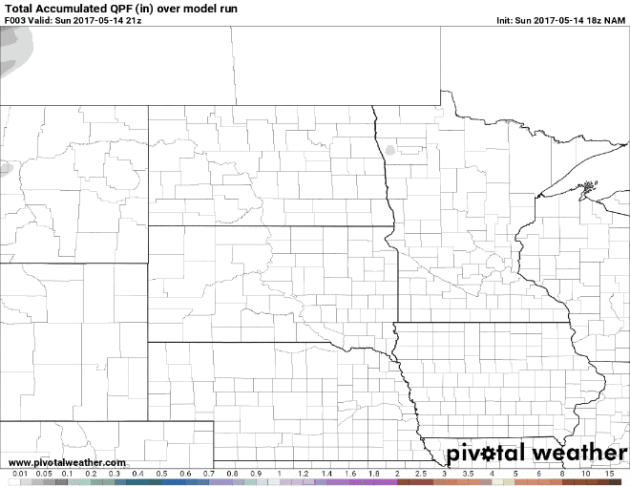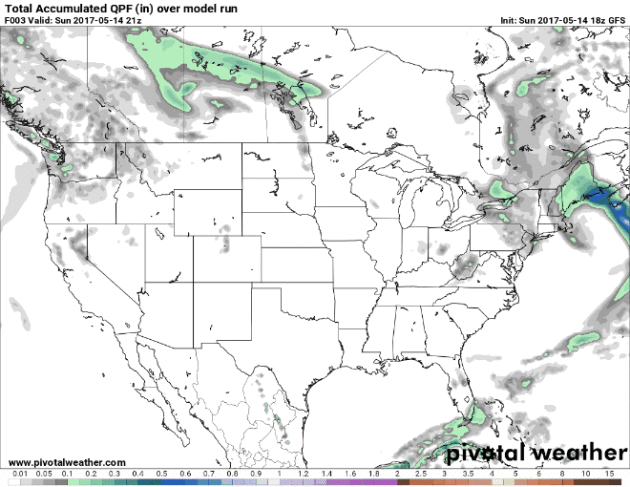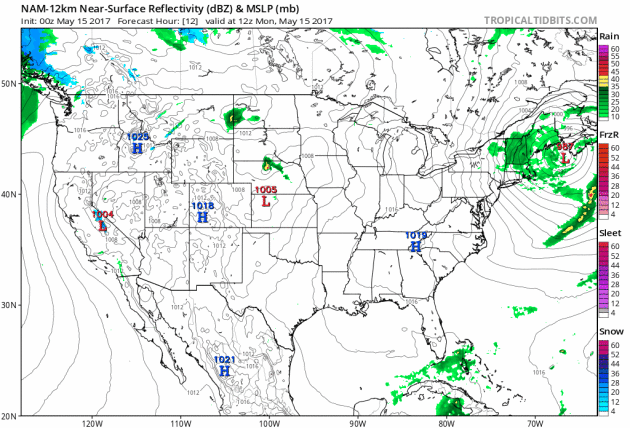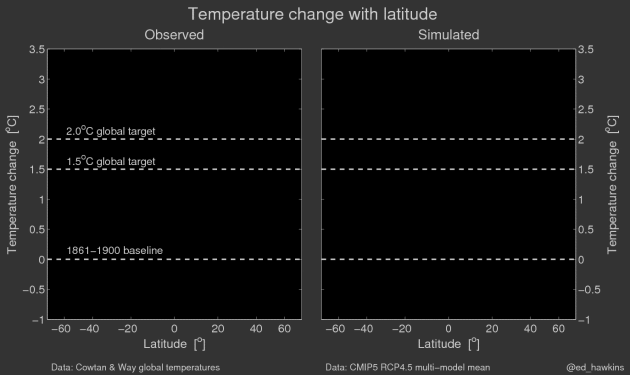81 F. high in St. Cloud on Sunday.
68 F. average high on May 14.
50 F. high on May 14, 2016.
May15, 1998:
Damaging tornadoes impact Minnesota. One tornado hits a flea market in
Albany, killing one person and injuring 30 others. 102 homes are
severely damaged in the northern Twin Cities due to another tornado.
May 15, 1969: Torrential rain occurs in Synnes Township, dumping 8 inches of rain in three hours.
Welcome to One of the Wetter Weeks of 2017"Honey,
I hope you never TIRE of me" I scribbled onto an overpriced Mother's
Day card. My wife's big gift was 4 new tires, because nothing says I
love you like good tread. Hey, cut me a break. Just trying to be
practical. Roses and chocolate only go so far.
We live in a world
of risk, but there are steps you can take to keep the odds in your
favor. Good tires, to avoid hydroplaning on wet roads. All-wheel drive
helps traction, year-round. NOAA Weather Radio. Staying indoors when
thunder is grumbling overhead. And not driving into flooded roads.
Nearly 600 Americans have died in floods since 2011; 61 percent of these
fatalities in vehicles. People consistently underestimate the depth of flood waters.
I
could see some flash flooding later this week as a series of storms
ripple along a slow-moving frontal boundary. The best chance of severe
storms and hail comes Tuesday; heaviest rains come Wednesday, again
Saturday. As much as 2-3 inches of rain may fall this week with highs in
the 50s Friday into Sunday.
Atmospheric payback for a flawless Fishing Opener/Mother's Day weekend? You 'betcha.
 Mom vs. Weather.
Mom vs. Weather. Thanks to the Twin Cities National Weather Service for passing this along. Mom wins every time.
One of the Wetter Weeks of 2017.
A series of storms rippling along a very slow-moving frontal boundary
will keep heavy showers and T-storms in the forecast from tonight into
next weekend. Amounts will be all over the map, but some 2-5" amounts
can't be ruled out over the next 7 days. Graphic: NOAA.
Serious Puddles.
No need to water the lawn anytime soon. NAM guidance is printing out
some 2-4" rains for much of Minnesota by Thursday, as heavy
thunderstorms redevelop over the same counties, a potential "train-echo"
effect that may result in flash flooding for some counties by midweek.
84-hour rainfall potential: NOAA and Pivotalweather.com.
16-Day Rainfall Totals.
Again, this is a model (GFS), which may be underestimating or
overestimating rainfall amounts, but check out the 3-7" bulls-eye for the
Upper Midwest and New England and the Northeast; more extreme rains
possible for Texarkana late in the period. Gazing at the maps I don't
think drought will be a glaring issue for most of the USA this year. GFS
accumulated rainfall product: Pivotalweather.com.
East Clears - Very Soggy Pattern Central USA.
The blocking pattern spinning up a persistent coastal storm for New
England and more rain for the Pacific Northwest causes an eastbound cool
front to temporarily stall over the Upper Midwest this week, resulting
in as much as a month's worth of rain or more in the next 7 days for
parts of Iowa, Minnesota and Wisconsin. 84-hour Future Radar NAM
product: Tropicaltidbits.com.
7-Day Ensemble Forecast.
NOAA is predicting a huge swath of 3-6" rains over the next 7 days from
Texas northward to Minnesota and Wisconsin, capable of flash flooding
and river flooding by next weekend.
Warm and Sticky, Then a Cooler Slap.
Relative warmth hangs on into early Wednesday (80s possible Tuesday if
we break out into the warm sector) but a stiff northeast breeze kicks in
the latter half of the week and daytime highs may not get out of the
50s in the Twin Cities Thursday into Sunday. ECMWF guidance for the Twin
Cities: WeatherBell.
Slow Warming in Time for Memorial Weekend.
After a chilly relapse for the Plains and Upper Midwest later this week
temperatures are forecast to mellow by the end of May as a ridge of
high pressure builds across the USA; cool and showery weather still
favored for parts of the western USA in 2 weeks.
 Two Catastrophic Floods in Less Than Two Years Wasn't Just a Case of Bad Luck
Two Catastrophic Floods in Less Than Two Years Wasn't Just a Case of Bad Luck. Turns out it was a convergence of factors. Some perspective on recent flooding at
St. Louis Post-Dispatch: "...
Extreme
bouts of precipitation don’t always translate to extreme floods, owing
to a variety of factors such as soil moisture. Nonetheless, flood risk
is rising with episodes of heavy rainfall becoming more common
in the Midwest, says Ken Kunkel, a professor who researches extreme
weather at North Carolina State University and is also involved with the
National Climate Assessment.
“Every decade has been higher than the previous decade in terms of
these events,” Kunkel said. He says studies link more frequent downpours
to rising global temperatures, which add more water vapor to the
atmosphere, increasing the potential for precipitation whenever a storm
system comes along. “They’ve got more fuel to work with, with more water
vapor,” Kunkel said..."
Photo credit: David Carson, St. Louis Post-Dispatch.
 Large Floods Can Flood Aging Sewer Systems with Harmful Bacteria, Viruses.
Large Floods Can Flood Aging Sewer Systems with Harmful Bacteria, Viruses. Well here's an implication of more heavy rain events I hadn't pondered before, courtesy of
terradaily.com: "
Researchers
have discovered a worrying link between heavy rainfall and upticks in
infections caused by bacteria and viruses carried by human waste. The
correlation was identified in cities with aging sewer systems. Modern
sewer systems separate human waste and storm runoff. But in many old
sewer systems, a single pipe handles both. Environmental scientist
Jyotsna Jagai has spent several years studying the human health risks
associated with "combined sewers," which are found in more than 70 major
American cities. In 2014, Jagai began comparing rainfall data with
hospital records in Massachusetts between 2003 and 2007. In cities with
combined sewers, Jagai found heavy rains led to an 13 percent increase
in gastrointestinal disorders linked to human waste-borne bacteria and
viruses..."
Last Friday Was 20th Anniversary of "Great Miami Tornado". Here's a video link and story from
NBC 6 in South Florida: "
Friday
marks the 20th anniversary of the infamous twister known as the "Great
Miami Tornado." The F1 tornado was eight miles long with winds between
100 to 120 mph when it struck on May 12, 1997..."
Traumatized by Hail. Check out the video from a recent hailstorm in Colorado, featured at
Holy Kaw!, and ask yourself how you would have handled this: "
As
if having four kids in the car in the school pickup line wasn’t bad
enough, this mom then had to keep things calm as hail smashed the
windows of her minivan and chaos ensued. The storm in Golden, Colorado
only lasted a few minutes, but that was enough to do some serious
damage.
I was outside of the elementary
school waiting to pick up my first grader, and just as the bell rang the
sky started assaulting us with giant hail balls of doom. The hail storm
came out of nowhere, and we are very thankful none of the kids had been
released from school before the hail began falling. The Honda Odyssey
is battered and broken, but the kids are all safe..."
Portland Becomes Home to USA's First Electric Showcase. Try before you buy - makes sense to me. Details at
insideevs.com: "
Imagine
a place to check out EVs, learn about EVs, and test drive EVs, with no
hassle to buy (because it’s not a dealership). This is all a reality at
Portland’s new Go Forth Electric Showcase. The Showcase officially
opened in downtown Portland, Oregon, and it’s the first of its kind in
the United States. The Electric Showcase intends to educate without
sales pressure. You can enjoy a fleet of electric cars to compare and
drive, and also use interactive displays to learn about how EVs work.
There is also information related to charging, and station locations.
You can use Forth’s interactive tools to help figure out which EV is
your best fit. Executive director of Forth, Jeff Allen, shared with KGW
Portland:
“It gives them a chance to try
them out, take a car for a test drive, actually practice plugging in the
charger and see what that feels like and learn about all their options
in a stress free environment...”
Photo credit: "
Inside the Go Forth Electric Showcase." (Image Credit: flickr via Zax9000).
Press the Button. Do you like ordering up food on tablets?
Miss the human interaction? How will automation impact the food
services industry, which employs 10% of the American workforce? Here's
an excerpt of an interesting post at
Lucky Peach: "...
On
a smaller scale, that’s what’s likely to play out in the restaurant
industry, if server and cashier automation picks up the pace. Fast
casual and fast food restaurants are already weighted toward kitchen
staff, and replacing front-of-house workers with more efficient
computerized systems (that also reduce the time customers spend at the
table) will only increase the order volume that a given restaurant
can process. This change mirrors the larger hollowing out of
middle-income jobs in America. Because unless something drastic happens,
all those new back-of house jobs are going to be worse than the waiting
jobs they replace. For all the love that the food media showers on
chefs, the overwhelming majority of kitchen jobs are still extremely
poorly paid..."
Simple Math is Why Elon Musk's Companies Keep Doing What Others Don't Even Consider Possible. I'm convinced Mr. Musk is from a different galaxy, sent here to save us from ourselves. Here's an excerpt at
Quartz: "...Does it all add up? “
Nothing is impossible, but all of it is very difficult,” says Gregory Hauser, a civil engineer at Dragados who recently managed the replacement of Seattle’s Alaskan Way Viaduct,
the largest underground highway project in the US. “I think [The Boring
Company] is on par with SpaceX.” Hauser said Musk’s calculations elide
serious technical complexities, and today’s technologies are not up to
the job. But after 40 years of incremental innovation, most of it from
outside the US, “I’m all for it,” he said. “The industry needs new
thinking and technology.” Executing on these ideas will require the
world’s most advanced engineering, but spotting unexpected solutions
just takes an uncommon clarity of mind..."
Photo credit: "
A slightly different perspective."
(SpaceX).
Why Would Aliens Even Bother With Earth? If they're reading our tweets they'll steer clear. Here's a thought-provoking post at Literary Hub: "...Don’t
get me wrong—if the Earth received an alien tweet tomorrow, or some
other text message beamed at us by radio or laser pulse, then I’d be
absolutely thrilled. So far, though, we’ve seen no convincing evidence
of other civilizations among the stars in our skies. But let’s say, just
for the sake of argument, that there are one or more star-faring alien
civilizations in the Milky Way. We’re all familiar with Hollywood’s
darker depictions of what aliens might do when they come to the Earth:
zapping the White House, harvesting humanity for food like a herd of
cattle, or sucking our oceans dry. These scenarios make great films, but
don’t really stand up to rational scrutiny. So let’s run through a
thought experiment on what reasons aliens might possibly have to visit
the Earth, not because I reckon we need to ready our defenses or
assemble a welcoming party, but because I think considering these
possibilities is a great way of exploring many of the core themes of the
science of astrobiology..."

TODAY: More clouds. Few T-storms nearby. Winds: SE 7-12. High: 79
MONDAY NIGHT: T-storms in the area. Low: 64
TUESDAY: Strong to severe T-storms. Steamy humidity levels. Winds: S 15-25. High: 85
WEDNESDAY: Rain may be heavy at times. Winds: NE 10-15. Wake-up: 63. High: 74
THURSDAY: Damp start, then clearing. Winds: NE 10-15. Wake-up: 51. High: 61
FRIDAY: Sunny start, showers arrive late. Winds: E 10-15. Wake-up: 46. High: 58
SATURDAY: More rain, few T-storms. Winds: E 10-15. Wake-up: 49. High: 59
SUNDAY: Still cool and foul. Chance of more light rain. Winds: NE 10-15. Wake-up: 47. High: 57
Climate Stories...
Wild Weather and Climate Change: Scientists Are Unraveling the Links. The
subject of "attribution" is coming up withh greater frequency: did
climate change flavor a specific event, make it hotter, wetter or drier?
Here's an excerpt from
Yale E360: "...
The Bulletin
of the American Meteorological Society (BAMS) has published an annual
report explaining extreme weather events from a climate perspective
since 2012, making it easy to see how far attribution studies have come.
Its first edition looked at a half-dozen events, from anomalous
temperatures to droughts. The most recent 2016 edition tackles
more than 20 events ranging from extreme winter sunshine in the U.K.
(made 1.5 times more likely by climate change) to an extreme wildfire
season in Alaska (dry fuel conditions were made 34 to 60 percent more
likely by climate change). Scientists can now tackle smaller weather
events, to better separate the impact of natural climate wobbles like El
Niño, and to start addressing more complicated systems like cyclones.
At the cutting edge of these analyses are projects aiming to attribute
bad weather to climate change as extreme events are actually happening,
not a year or a decade later..."
The Injustice of Atlantic City's Floods. The
wealthy will be able to sell and move, even if they take a loss, but
rising seas and increased frequency of coastal flooding will hit the
poor the hardest, according to a story at
Climate Central: "
Coastal
communities are enduring growing flood risks from rising seas, with
places like Atlantic City, sandwiched between a bay and the ocean,
facing some of the greatest threats. Guided by new research by Climate
Central’s Scott Kulp and Benjamin Strauss, reporter John Upton and
photographer Ted Blanco chronicled the plight of this city’s residents
as they struggle to deal with the impacts. Upton spent months
investigating how the city is adapting, revealing vast inequity between
the rich and the poor..."
Photo credit: "
Eileen DeDomenicis on the patio of her home on Arizona Avenue as a high tide and rain cause flooding in parts of Atlantic City." Credit: Ted Blanco/Climate Central.
 Nash: Yes, Virginia the Threat of Climate Change is Real
Nash: Yes, Virginia the Threat of Climate Change is Real. Here's an excerpt of an Op-Ed that caught my eye in
The News & Advance in Lynchburg, Virginia: "...
Both
Democrats and Republicans have a serious case of the slows, perhaps
hoping the problem will just go away. Ask your political
representatives, or candidates in the upcoming elections, why that is
and what they’ll do about it. Compared to other states, we fail to push
for rapid conversion to solar power and other renewable energy sources,
aggressive fuel economy requirements for cars, and planning for the
changes we will face. Already, Norfolk and Virginia Beach have chronic
flooding — about half of it the result of sea level rise from record
melting of the Earth’s icecaps. Our coastal waters will be about 1.5
feet higher sometime between 2030 and 2050. That’s enough to drown
several billion dollars’ worth of commercial and residential real
estate, dozens of miles of highways and rails, and a third of our port
facilities..."
Current Wildfires. WXshift has a running tally with background information on trends with fire frequency and intensity: "
Since
1970, the annual average number of wildfires larger than 1,000 acres
has more than doubled in the western U.S. The typical wildfire season
has also stretched by about two and a half months longer over that time.
The main cause has been rising temperatures that have led to earlier
snowmelt in the western U.S., which has led to drier conditions. These
factors are helping drive an increase in the total area burned.
Projections indicate that for every 1.8°F further rise in temperature —
and the western U.S. could see average temperatures rise by up to 9°F by
2100 — there could be a quadrupling in the area burned each year in the
western U.S..."
Global Warming: There Is No Debate. Here's an excerpt of an Op-Ed at
TheStarPress: "...
Sure
there were floods, droughts, hurricanes and tornadoes, but anyone with
mild observation will attest something is different today. As I write
this letter, five islands in the Pacific have vanished with more to
come. The city of Miami is building higher streets and has installed
more than $500 million worth of pumps to deal with the ocean water
coming into the city (which will be obsolete in 15 years). Undeniable is
the NASA imagery and data or the realization that the past three years
were the hottest on record. It seems to me what will be humans’ tragic
undoing for future generations will be simple greed. The same
manipulators of misinformation that the cigarette companies used years
ago are now working full force for the fossil fuel industry. The masses
take the bait hook, line and sinker. I suppose this is all attributed to
the selfish gene in humans, or the philosophy to just live for today,
with no thought of tomorrow but either way it will be unbelievable
suffering for humans sooner than later..." (File photo: PBS).
 Study: Chicago's Forests Threatened by Climate Change.
Study: Chicago's Forests Threatened by Climate Change. Minnesota is experiencing similar trends. Here's an excerpt from a story at
Chicago Today, courtesy of WTTW-TV: "
A
first-of-its-kind study shows that forests in Chicago and surrounding
areas face significant threats from climate change, with native trees
especially vulnerable to increases in temperature, precipitation and
other changes. In conducting the study, a team led by the U.S. Department of Agriculture’s Forest Service
evaluated a 7-million-acre area covering parts of Illinois, Indiana,
Michigan and Wisconsin. Researchers documented past and current
conditions, summarized potential impacts of climate change on urban
forests and outlined strategies for municipalities, park districts and
forest preserve districts to manage the changes. One of the study’s key
findings was that 15 percent of tree species in the region have either
moderately high or high vulnerability to climate change..."
Photo credit: Flickr / Laura Marie.
 Ocean Acidification.
Ocean Acidification. Not a theory, model or forecast, but a reality today. Graphic: Skeptical Science.
Zonal Mean Temperature Change in Observations and Models.
Here is a very effective graphic, showing observed vs. predicted
temperatures by latitude. All in all the climate models have done a
remarkably good job. Here's an excerpt from
Climate Lab Book: "...
The
figure below shows the zonal mean from observations (left) and the
average of many different climate models (right). The different coloured
lines represent every year from 1861-2016. The dashed horizontal lines
indicate the 1.5°C and 2°C global temperature targets suggested by the
UNFCCC in the Paris Agreement. An animated version is available by
clicking on the image, which also extends the model simulations to 2100
with a medium emissions scenario (RCP4.5). The observations clearly show
more variability from year-to-year. This is to be expected as by taking
the average of the models we are removing variability from the
simulated panel. For example, the observed warming due to the large El
Nino of 1877-78 can be seen, along with the warming in the Arctic in the
1940s and subsequent cooling. These are examples of natural variations
occurring on top of the long-term trend..."
* thanks to AerisWeather modeling genius Patrick Francis for passing this post along.







No comments:
Post a Comment